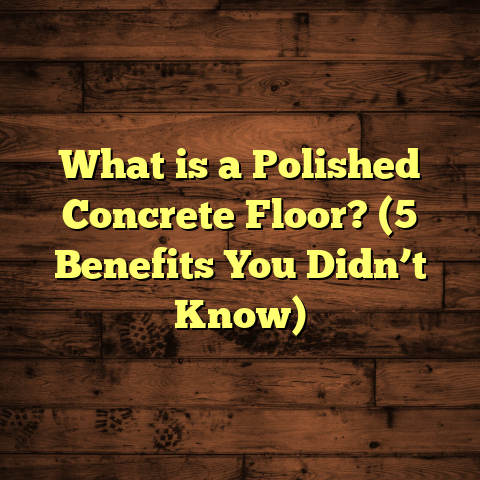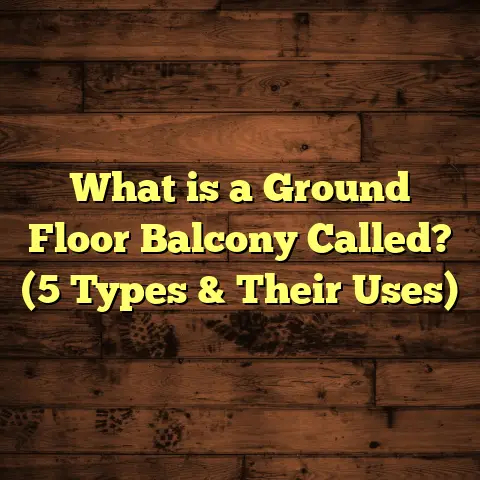What is Better for Flooring: Ceramic or Porcelain? (5 Key Differences)
Imagine walking barefoot on a smooth, cool surface
that looks like stone but feels almost like glass beneath
your feet. Now, imagine stepping on a similarly beautiful
floor, but this time it’s matte, slightly textured, and you can
feel the grit of the material grounding your steps. Both floors
look stunning, both are durable, yet they each offer something
quite different. This contrast is what I often encounter when
helping clients decide between ceramic and porcelain flooring.
These two materials often confuse people because they share
many similarities but have key differences that affect how they
perform and how you live with them. I’ve spent years working
with both, installing them in homes, offices, restaurants, and
even outdoor patios. I want to share what I’ve learned in detail—
including some little-known facts and real-world examples that
can help you make a choice you’ll be happy with for decades.
What is Ceramic and Porcelain Flooring?
Ceramic and porcelain tiles are both types of clay-based products
that go through high-temperature firing. But these similarities end
there in terms of their performance and best applications.
Ceramic tiles are made primarily from red or white natural clay,
mixed with other natural materials like sand and water. The clay
is shaped into tiles and then fired at temperatures typically around
1,000–1,150°C (1,832–2,102°F). The result is a sturdy tile that is
usually glazed to add color, pattern, or texture.
Porcelain tiles are a subtype of ceramic made from finer clays and fired
at higher temperatures—around 1,200–1,400°C (2,192–2,552°F). This
higher firing temperature causes vitrification—a process where the tile
becomes denser and less porous.
The key takeaway? Porcelain is essentially a more refined and durable
version of ceramic tile.
Porcelain is a type of ceramic tile—but not all ceramic tiles are porcelain.
I remember one client who was ready to buy “ceramic” tiles for their outdoor patio, only to realize later that true porcelain tiles were better suited for the freeze-thaw cycles in their region. This distinction saved them from costly repairs a few years down the line.
1. Durability and Strength
One of the most important factors when choosing flooring is durability. No one wants a floor that chips or cracks after a year or two of normal use.
Porcelain tiles are incredibly tough because of their dense structure. The fine clay particles and high firing temperature cause porcelain to be harder and more resistant to wear and tear than ceramic. This makes porcelain ideal for heavy traffic areas like commercial kitchens, entryways, or busy family rooms.
Ceramic tiles are strong but generally less so than porcelain. They’re perfect for low to medium traffic areas but may not hold up as well under constant heavy foot traffic or impacts.
Hardness Scale
To give you some concrete data: porcelain tiles typically rank between 7-10 on the Mohs hardness scale—where 10 is diamond-hard—while ceramic tiles usually fall between 5-7. This difference means porcelain resists scratches and impacts better.
Real-world Example
I installed porcelain tile flooring in a bustling restaurant last year. The kitchen staff dropped heavy pots regularly, but the floor remained intact with no chips or cracks after 18 months of heavy use. In contrast, a nearby café using ceramic had to replace several cracked tiles in the same period.
Breaking Strength
Porcelain also scores higher in breaking strength tests. Typical porcelain tiles withstand about 2,000-4,000 pounds per square inch (psi), while ceramic ranges from 800-1,600 psi. That’s more than double the strength in some cases.
This strength translates to fewer repairs and longer-lasting floors—something to seriously consider if you want your floor to look new for years.
2. Water Absorption and Moisture Resistance
Water absorption rates reveal how much moisture a tile absorbs when submerged in water for a period of time. Low absorption rates mean less water penetrates the tile body, leading to better resistance against stains, mold, and freeze damage.
Porcelain tiles have an absorption rate of less than 0.5%, which classifies them as impervious tiles. Ceramic tiles absorb between 3%-7% depending on their composition and glazing.
Why Does This Matter?
If you’re installing floors in bathrooms, kitchens, basements, or outdoor areas exposed to rain or snow, water resistance matters a lot. High absorption ceramic tiles can trap moisture internally if not properly sealed or glazed.
This trapped moisture can lead to:
- Mold growth
- Tile swelling or warping
- Cracking during freeze-thaw cycles
Case Study: Coastal Homes
In coastal areas where humidity is high and salt spray is common, I’ve seen porcelain tiles outperform ceramic by a wide margin. One homeowner near the Atlantic coast had ceramic floor tiles in her bathroom that started showing discoloration and grout deterioration within two years. After switching to porcelain in her next renovation, she noticed no damage after five years despite similar conditions.
Freeze-Thaw Resistance
Porcelain’s low absorption means it handles freeze-thaw cycles without cracking. Ceramic is more vulnerable unless it’s specifically rated for outdoor use.
According to the Tile Council of North America (TCNA), the freeze-thaw resistance of porcelain reduces tile failures by up to 90% compared to ceramic in cold climates.
3. Design Flexibility and Appearance
For many people, how the floor looks is just as important as how it performs.
Ceramic tiles are often glazed with vibrant colors and intricate patterns because their porous body absorbs glazes easily before firing. This allows manufacturers to create an endless variety of styles—everything from traditional terracotta reds to bright blues and greens.
Porcelain has traditionally been more limited in color range due to its density making glaze absorption tricky. But modern technology has changed this dramatically.
Digital Printing Technology
Today’s porcelain tiles often use digital printing methods that can replicate natural materials like marble, wood grain, or concrete with stunning realism.
I recently worked on a project where the client wanted hardwood floors but needed waterproofing for their kitchen and entryway. We selected wood-look porcelain tiles with textured finishes that looked indistinguishable from real wood but were much easier to maintain.
Style Variety
- Ceramic: Best for colorful patterns, artistic designs, mosaics.
- Porcelain: Best for stone-like textures, wood looks, subtle matte finishes.
Cost vs Appearance Tradeoff
Ceramic tiles typically cost between $1 to $15 per square foot depending on style and quality. Porcelain tends to run higher—from $3 to $25 per square foot, especially for premium digitally printed types.
For budget-conscious projects where style matters but heavy wear isn’t expected (like walls or light-use rooms), ceramic offers huge value. For spaces where appearance must meet tough wear standards (commercial spaces or wet rooms), porcelain is usually worth the investment.
4. Installation Complexity and Cost
Installing tile isn’t just about sticking it on the floor—it requires skill and the right tools.
Because porcelain is denser and harder than ceramic:
- Cutting porcelain requires specialized wet saws with diamond blades.
- Drilling holes or shaping edges takes more time.
- The weight of porcelain makes handling more labor-intensive.
All this means installers charge more for porcelain projects—typically 20-30% higher labor costs than ceramic installations.
Installation Tips From My Experience
When working with porcelain:
- Make sure your contractor uses professional-grade tile cutters.
- Expect longer installation times.
- Budget for higher labor costs upfront.
With ceramic:
- Installation tends to be faster.
- You can sometimes get away with simpler tools.
- Labor costs can be lower by up to 30%.
Waste Factor
I always advise clients to order an extra 10-15% of tile material to account for cutting waste or breakage during installation—especially with porcelain where cuts are more difficult and expensive.
Subfloor Preparation
Both ceramic and porcelain need flat, stable subfloors for best results. Uneven surfaces can cause cracking regardless of tile type. I’ve seen many cases where poor subfloor prep caused failures mistaken as tile defects.
5. Maintenance and Longevity
Once installed, keeping your floor looking great depends on maintenance habits matched to your tile type.
Porcelain’s low porosity means spills don’t penetrate easily; dirt wipes off without much effort; mold growth is minimal; grout stays cleaner longer.
Ceramic needs more care because:
- Its higher porosity allows stains if glaze chips.
- Grout lines can discolor faster.
- Chips happen more easily if hit hard.
Cleaning Tips
For both types:
- Sweep or vacuum regularly.
- Mop with mild detergent.
- Avoid harsh chemicals or abrasive scrubbers that can damage glaze or grout.
For ceramic floors:
- Periodic grout sealing can extend life.
- Prompt cleanup of spills prevents staining.
- Replace chipped tiles sooner to avoid water damage underneath.
For porcelain floors:
- Usually no sealing needed.
- Easier stain resistance.
- Longer life expectancy: 50+ years compared to ceramic’s 20-30 years average in similar conditions.
More Insights From My Projects
Over my career, I’ve helped hundreds choose between these two flooring options. Here are some insights from real jobs that might help:
Family Homes & Kids
Families with kids tend to favor porcelain because it stands up better to toys being dropped or rough play. Ceramic can chip more easily under these conditions unless very thick high-quality types are used.
Commercial Spaces
Restaurants, retail stores, and offices often require porcelain for its durability and stain resistance—especially in areas exposed to grease or moisture.
Outdoor Use
Porcelain is usually the safer bet outdoors due to weather resistance unless you get frost-resistant ceramics made specifically for exterior use—but they cost more and are less common.
Data Summary: Industry Statistics
Here’s some data from industry reports that back up what I see on the ground:
| Attribute | Ceramic Tiles | Porcelain Tiles |
|---|---|---|
| Water Absorption Rate | 3%-7% | <0.5% |
| Breaking Strength (psi) | 800 – 1,600 | 2,000 – 4,000 |
| Typical Cost per Sq Ft | $1 – $15 | $3 – $25 |
| Average Lifespan | 20 – 30 years | 50+ years |
| Maintenance Level | Moderate | Low |
| Installation Labor Cost | Lower | Higher |
| Freeze-Thaw Resistance | Moderate | Excellent |
How I Help Clients Decide
When someone asks me whether they should pick ceramic or porcelain flooring I ask questions like:
- What room(s) are you flooring?
- How much foot traffic do you expect?
- Will the floor see water regularly?
- What’s your budget for installation?
- How long do you want this floor to last?
- Are you looking for a specific design style?
Answering these helps us narrow down the choice quickly.
If the kitchen or bathroom is involved—or outdoor areas—I lean strongly toward porcelain due to durability and moisture resistance.
If you want colorful patterns indoors with moderate use—and lower upfront cost—ceramic makes sense.
Personal Story: Mixing Both Tiles
One project I’m proud of was a renovation of an old farmhouse kitchen where my clients wanted charm plus durability.
We used colorful ceramic tiles on the backsplash walls, which gave a warm artistic vibe with hand-painted patterns.
For floors we chose matte finish porcelain that mimicked weathered stone but handled spills well and cleaned easily after family meals.
This combo delivered style without compromising function or budget.
Environmental Considerations
Both ceramic and porcelain tiles come from natural materials (clay), but manufacturing energy use varies:
- Porcelain requires more energy due to higher firing temperatures.
- Both can be recycled or reused if carefully removed.
- Some manufacturers now offer eco-friendly options made from recycled content.
Choosing either type with local suppliers can reduce your project’s carbon footprint by minimizing transportation emissions.
Final Thoughts: What Works Best For You?
Picking between ceramic and porcelain isn’t about which tile is better universally—it’s about which suits your space best based on how it will be used and cared for.
Porcelain’s toughness and water resistance make it unbeatable in wet or high traffic areas—but comes at higher cost and installation complexity.
Ceramic offers vast design options at lower prices but requires more maintenance and is less durable under heavy wear or moisture exposure.
If you want help estimating costs tailored to your location’s labor rates and materials prices—check out tools like FloorTally—they make budgeting easy so you don’t get surprises during installation.
What kind of space do you want new flooring for? Drop me a line if you want advice specific to your project!





